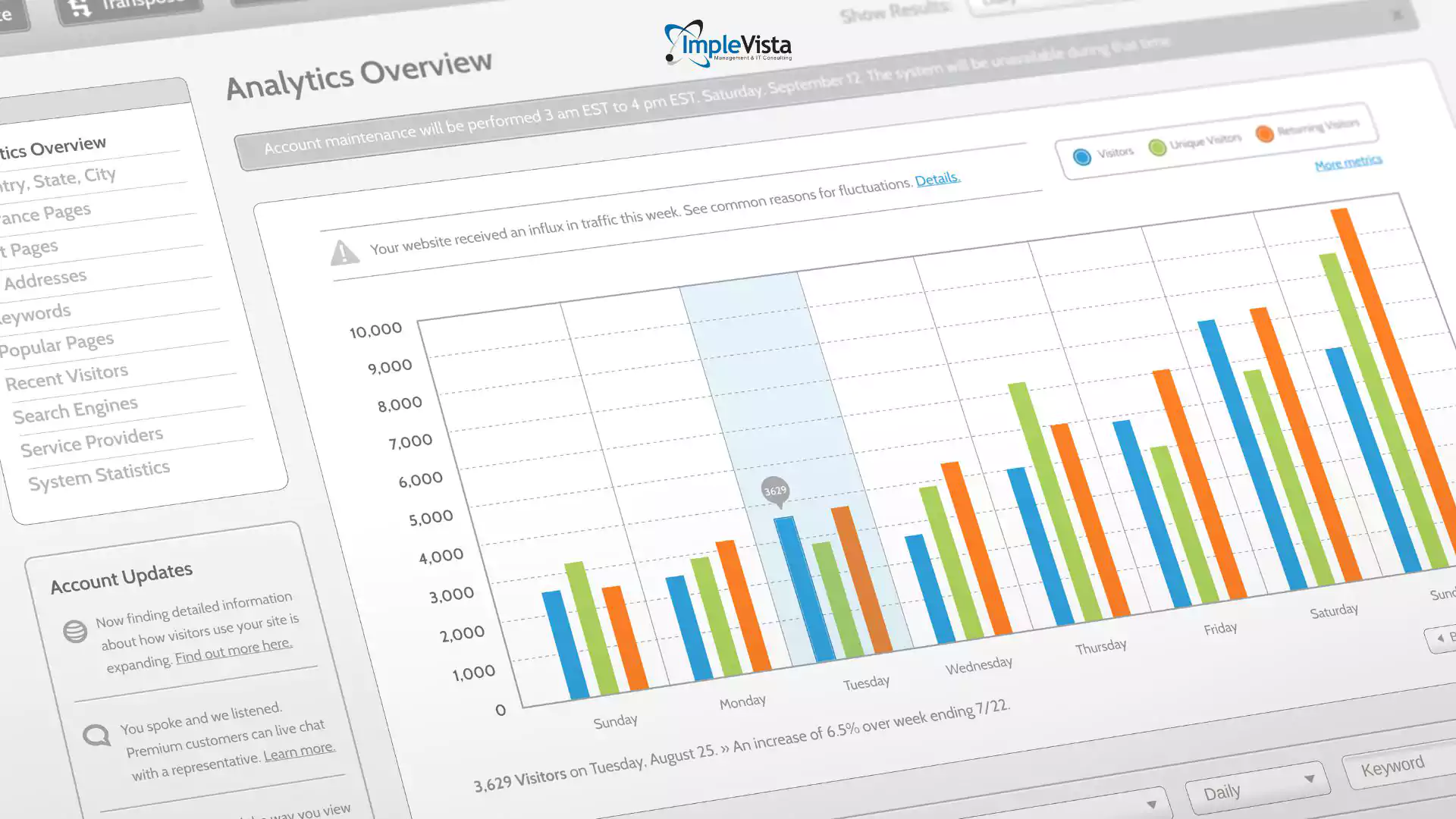Your website is more than just a digital presence; it’s a powerful marketing tool that can turn visitors into customers. However, simply attracting traffic isn’t enough. You need to ensure that the traffic you generate converts into meaningful actions, whether it’s making a purchase, signing up for a newsletter, or filling out a contact form. Conversion rates are critical to the success of your online marketing efforts, and optimizing them is key to maximizing the value of your website.
Digital Implevista specializes in helping businesses in Dhaka, Bangladesh, and beyond increase their website conversion rates through proven strategies and cutting-edge digital marketing techniques.
Understanding Website Conversion Rates
Before we get into optimization strategies, it’s essential to understand what we mean by website conversion rate. A website conversion rate refers to the percentage of visitors who complete a desired action on your website. This action could range from purchasing a product to signing up for a newsletter. Calculating your website conversion rate is simple:
Website Conversion Rate=(Conversions/Total Visitors)×100\text{Website Conversion Rate} = \left( \frac{\text{Conversions}}{\text{Total Visitors}} \right) \times 100Website Conversion Rate=(Total Visitors/Conversions)×100
If you have 1,000 visitors and 50 complete an action, your website conversion rate is 5%.
The Importance of Website Conversion Rate Optimization (CRO)
Optimizing your website’s conversion rate is one of the most efficient ways to drive revenue growth without increasing traffic. Even a small increase in conversion rates can lead to substantial business results. By analyzing user behavior and making data-driven adjustments, Digital Implevista can help you tap into the full potential of your website. CRO involves identifying roadblocks to conversion, testing new approaches, and continuously refining your site’s performance.
How to increase the conversion rate on a website?
Increasing the conversion rate on a website involves optimizing various elements that influence user behavior and engagement. Here are some effective strategies to boost your website’s conversion rate:
1. Improve Website Load Speed
- Why it Matters: Faster-loading websites provide a better user experience. Studies show that even a one-second delay in load time can significantly decrease conversion rates.
- How to Implement: Compress images, use faster hosting services, minimize redirects, and leverage browser caching.
2. Optimize for Mobile Users
- Why it Matters: With over 50% of global web traffic coming from mobile devices, it’s essential to ensure your website is mobile-friendly.
- How to Implement: Use responsive design, simplify navigation, and optimize forms for mobile use.
3. Create Clear, Compelling CTAs (Call-to-Action)
- Why it Matters: A well-placed and persuasive CTA guides users toward taking the desired action, whether it’s making a purchase, signing up, or downloading a resource.
- How to Implement: Use action-oriented language, design prominent buttons, and place CTAs strategically on high-traffic pages.
4. Use A/B Testing
- Why it Matters: A/B testing helps you compare two versions of a page element (like headlines, CTAs, or images) to see which one performs better.
- How to Implement: Use tools like Google Optimize or Optimizely to test different variations and make data-driven decisions for improvements.
5. Simplify Navigation
- Why it Matters: Clear and intuitive navigation helps users easily find what they’re looking for, reducing bounce rates and encouraging conversions.
- How to Implement: Limit menu options, use breadcrumb trails, and make sure important links are easy to find.
6. Enhance Website Trustworthiness
- Why it Matters: Building trust is essential for conversions, especially if users are expected to share personal information or make a purchase.
- How to Implement: Display security badges, customer reviews, and testimonials. Ensure your site has an SSL certificate (HTTPS).
7. Leverage Social Proof
- Why it Matters: People tend to trust the opinions and actions of others. Displaying reviews, testimonials, and case studies can influence a visitor’s decision to convert.
- How to Implement: Feature customer testimonials, showcase case studies, and display user-generated content or ratings prominently on product pages.
8. Personalize User Experience
- Why it Matters: Personalized content creates a more relevant experience for users, increasing engagement and the likelihood of conversions.
- How to Implement: Use data from past user behavior or geographic location to tailor content and product recommendations.
9. Optimize Your Forms
- Why it Matters: Complex or lengthy forms can deter users from completing a conversion. Simplified forms encourage more people to sign up or share their details.
- How to Implement: Reduce the number of form fields, use auto-fill features, and break long forms into smaller steps if necessary.
10. Offer Incentives
- Why it Matters: Offering discounts, free trials, or bonuses can push users to convert.
- How to Implement: Create limited-time offers, first-time user discounts, or free shipping for purchases to encourage immediate action.
11. Use Engaging Visuals and Videos
- Why it Matters: High-quality visuals and videos keep visitors engaged, explain complex ideas quickly, and improve the overall user experience.
- How to Implement: Use product videos, customer success stories, or explainer videos to showcase your offerings.
12. Make the Checkout Process Easy
- Why it Matters: A complicated checkout process leads to cart abandonment and lower conversions.
- How to Implement: Simplify the checkout process by offering guest checkout, minimizing form fields, and providing multiple payment options.
By implementing these strategies, you can create a user-friendly, engaging, and optimized website that drives higher conversion rates.
Effective Strategies for Increasing Your Website Conversion Rates
Here are the most effective strategies that Digital Implevista uses to optimize your website’s conversion rates:
1. Optimize for Mobile Users
Mobile devices account for more than half of all web traffic, so optimizing your site for mobile is crucial. A mobile-responsive design ensures that your website loads quickly, looks great, and functions well on any device. Slow-loading pages and poor navigation can frustrate mobile users, leading to a higher bounce rate and lower conversions.
How Digital Implevista Helps:
We implement mobile-first designs and test your site’s responsiveness across various devices, ensuring a seamless experience for all users.
2. Improve Page Load Speed
The average user expects a webpage to load in under three seconds. If your website is slow, potential customers may abandon it before they even have a chance to engage. Fast websites not only enhance user experience but also improve SEO, which can lead to more traffic.
How Digital Implevista Helps:
Our team conducts speed audits and uses optimization techniques, such as compressing images, leveraging browser caching, and reducing server response times, to ensure your site runs smoothly and quickly.
3. Create Clear and Compelling CTAs
Your Call-to-Action (CTA) is the most critical element of your website when it comes to conversions. A well-crafted CTA guides visitors toward completing your desired action. A weak or unclear CTA can confuse visitors or fail to motivate them to take action.
How Digital Implevista Helps:
We analyze your CTAs and refine them to be more direct, action-oriented, and visually appealing. By using persuasive language and design, we encourage higher engagement and conversion rates.
4. A/B Testing for Optimal Results
Testing different versions of your website elements is an effective way to discover what resonates most with your audience. A/B testing allows you to compare two variations of a webpage to see which one performs better in driving conversions.
How Digital Implevista Helps:
We conduct comprehensive A/B tests on different aspects of your website—such as headlines, images, and CTAs—to determine the best-performing versions that lead to improved conversion rates.
5. Simplify Your Website’s Navigation
A confusing or cluttered website navigation can frustrate visitors, causing them to leave without taking any action. Clear and intuitive navigation helps users find what they’re looking for quickly, leading to a smoother experience and higher conversions.
How Digital Implevista Helps:
We streamline your website’s navigation to ensure that users can easily access important information and complete actions with minimal effort.
6. Enhance Website Trustworthiness
Trust plays a significant role in conversion rates. Customers are more likely to complete a purchase or sign-up when they feel confident that your website is secure and reliable. Adding trust signals—like SSL certificates, reviews, testimonials, and guarantees—can help increase conversions.
How Digital Implevista Helps:
We integrate key trust elements such as customer reviews, security badges, and professional design to build credibility and reassure your visitors.
7. Leverage Social Proof
Social proof, such as testimonials, case studies, or user reviews, serves as powerful persuasion tools. It shows visitors that others have successfully used your product or service, which can influence their decision to convert.
How Digital Implevista Helps:
We help you highlight positive customer experiences by incorporating testimonials, reviews, and success stories that build credibility and inspire trust in your brand.
8. Use Personalized Content
Personalization can greatly increase your website’s conversion rate by making the visitor experience more relevant. Tailoring your content to the user’s behavior, preferences, or location helps engage them on a deeper level.
How Digital Implevista Helps:
We utilize advanced targeting and personalization techniques to display content that resonates with each visitor, increasing the likelihood of conversion.
9. Optimize Your Forms
Forms are a common element for lead generation, yet lengthy or complex forms can deter users from completing them. Reducing the number of fields and simplifying the process can significantly improve conversion rates.
How Digital Implevista Helps:
We audit your forms and recommend ways to simplify and streamline them, reducing friction and encouraging more users to fill them out.
10. Create Engaging and Relevant Content
Relevant, engaging content is essential to keep visitors on your site and moving through your conversion funnel. Content that is informative, easy to read, and tailored to your audience’s needs will naturally lead to higher conversion rates.
How Digital Implevista Helps:
Our content marketing experts create tailored, high-quality content that speaks directly to your target audience, guiding them toward conversion.
Measuring and Monitoring website Conversion Rate Success
Once these strategies are implemented, it’s essential to monitor their impact on your website conversion rates. Digital Implevista ensures ongoing optimization by setting up performance tracking through tools like Google Analytics, heatmaps, and conversion funnels.
Key Metrics to Monitor:
- Bounce Rate: The percentage of visitors who leave your site after viewing only one page.
- Average Session Duration: How long visitors stay on your site.
- Pages Per Session: The average number of pages a user visits during one session.
- Exit Rate: The percentage of visitors who leave from a specific page.
By continuously tracking these metrics, Digital Implevista identifies areas for improvement and fine-tunes your website for optimal conversion performance.
In today’s competitive digital landscape, increasing your website conversion rates is crucial to the success of your business. By implementing the strategies outlined above, you can create a more engaging, user-friendly, and conversion-optimized website. At Digital Implevista, we specialize in helping businesses maximize their website’s potential through data-driven conversion rate optimization techniques.
Whether you need help with website design, content creation, A/B testing, or performance monitoring, Digital Implevista is your partner for long-term success. Get in touch with us today to start turning more visitors into customers!
FAQs About website conversion rates
Q: What is a website conversion?
A: A website conversion occurs when a visitor to your website completes a desired action or goal that you’ve set. This action could be anything from making a purchase, signing up for a newsletter, filling out a contact form, or downloading a resource. Essentially, it’s when a user transitions from being a passive visitor to taking an active step toward engaging with your business.
Examples of Website Conversions:
- Purchasing a product or service (for e-commerce sites).
- Signing up for a newsletter or subscription.
- Filling out a contact or inquiry form.
- Downloading an eBook, guide, or resource.
- Registering for an event or webinar.
- Creating an account on the website.
Clicking on a specific CTA (Call-to-Action) like “Learn More” or “Get Started.”
The percentage of visitors who complete this action is referred to as the conversion rate. Improving this rate through various optimization techniques can help businesses achieve more goals with the traffic they already have.
Q: What is the conversion rate of a website ad?
A: The conversion rate of a website ad refers to the percentage of users who click on an advertisement and then complete a desired action, such as making a purchase, signing up for a service, or filling out a form. It measures how effectively your ad drives users to take the intended action.
Q: How to Calculate the Conversion Rate for a Website Ad:
A: The formula to calculate the conversion rate is:
Conversion Rate=(Number of Conversions/Number of Ad Clicks)×100\text{Conversion Rate} = \left( \frac{\text{Number of Conversions}}{\text{Number of Ad Clicks}} \right) \times 100Conversion Rate=(Number of Ad ClicksNumber of Conversions)×100
For example, if 100 people click on your ad and 5 of them make a purchase, your conversion rate would be:
(5100)×100=5%\left( \frac{5}{100} \right) \times 100 = 5\%(1005)×100=5%
Average Conversion Rate for Website Ads:
The average conversion rate for online ads can vary by industry and ad type. However, typical conversion rates for Google Ads are around 2-4%. Some highly optimized campaigns can achieve conversion rates above 10%.
Improving your ad’s targeting, design, messaging, and landing page experience can lead to higher conversion rates.
Q: What are conversion rates for SEO?
A: Conversion rates for SEO refer to the percentage of visitors who arrive at your website through organic search engine results (i.e., SEO) and then complete a desired action, such as making a purchase, signing up for a newsletter, or filling out a contact form.
How to Calculate SEO Conversion Rate:
The formula for calculating an SEO conversion rate is:
SEO Conversion Rate=(Number of Conversions from Organic TrafficTotal Organic Traffic)×100\text{SEO Conversion Rate} = \left( \frac{\text{Number of Conversions from Organic Traffic}}{\text{Total Organic Traffic}} \right) \times 100SEO Conversion Rate=(Total Organic TrafficNumber of Conversions from Organic Traffic)×100
For example, if your website gets 1,000 visitors from organic search and 50 of them convert, your SEO conversion rate is:
(501000)×100=5%\left( \frac{50}{1000} \right) \times 100 = 5\%(100050)×100=5%
Q: What is a Good SEO Conversion Rate?
A: The average SEO conversion rate can vary depending on the industry, product, or service. However, a good benchmark is typically around 2-5%. Some well-optimized websites can achieve higher conversion rates of 5-10% or more.
Factors Affecting SEO Conversion Rates:
- User Intent: High-converting SEO traffic often comes from users with clear purchase intent (e.g., searching for product reviews or prices).
- Content Quality: Relevant, well-written content that answers users’ questions can improve conversion rates.
- User Experience (UX): A user-friendly website with easy navigation, fast load times, and mobile optimization increases the likelihood of conversions.
- On-Page SEO: Well-optimized meta tags, headers, and calls-to-action (CTAs) can guide users toward completing a desired action.
By optimizing for the right keywords and improving the user experience, SEO can drive more targeted traffic and boost conversion rates.
Q: What is Google Ads conversion rate?
A: The Google Ads conversion rate refers to the percentage of users who click on your Google ad and then complete a desired action, such as making a purchase, filling out a form, or signing up for a newsletter. It measures how effectively your Google Ads campaign leads to conversions.
How to Calculate Google Ads Conversion Rate:
The formula to calculate the conversion rate for Google Ads is:
Conversion Rate=(Number of Conversions/Number of Ad Clicks)×100\text{Conversion Rate} = \left( \frac{\text{Number of Conversions}}{\text{Number of Ad Clicks}} \right) \times 100Conversion Rate=(Number of Ad ClicksNumber of Conversions)×100
For example, if 200 people click on your ad, and 10 of them convert (e.g., make a purchase), your Google Ads conversion rate would be:
(10200)×100=5%\left( \frac{10}{200} \right) \times 100 = 5\%(20010)×100=5%
Q: What is a Good Google Ads Conversion Rate?
A: The average Google Ads conversion rate varies by industry and campaign type, but generally, a good conversion rate is around 2-4%. However, some high-performing campaigns, especially those with well-targeted ads and optimized landing pages, can achieve conversion rates above 5-10%.
Factors Affecting Google Ads Conversion Rate:
- Ad Relevance: The more closely your ad matches the user’s search intent, the higher the likelihood of a conversion.
- Landing Page Quality: A well-designed, fast-loading, and relevant landing page can significantly improve conversion rates.
- Targeting: Precise targeting based on location, demographics, and user behavior helps attract more qualified leads, leading to higher conversions.
- Ad Copy and CTA: Engaging, clear ad copy with a strong call-to-action encourages users to click and complete the conversion.
Optimizing these factors can improve the conversion rate of your Google Ads campaigns, leading to better return on investment (ROI).
Q: What is CPM?
A: CPM stands for Cost Per Mille, where “mille” is Latin for thousand. In digital advertising, CPM refers to the cost of displaying an ad 1,000 times (impressions). It is a common metric used to price online advertisements, especially in display and banner ad campaigns.
How CPM Works:
Advertisers pay based on the number of times their ad is shown, regardless of whether users click on it. For example, if a website charges a CPM of $5, it means the advertiser will pay $5 for every 1,000 impressions (views) of the ad.
How to Calculate CPM:
The formula to calculate CPM is:
CPM=(Total Cost of the Ad/Total Impressions)×1,000\text{CPM} = \left( \frac{\text{Total Cost of the Ad}}{\text{Total Impressions}} \right) \times 1,000CPM=(Total ImpressionsTotal Cost of the Ad)×1,000
For instance, if you spend $50 on an ad campaign that generates 10,000 impressions, your CPM would be:
\left( \frac{50}{10,000} \right) \times 1,000 = 5 \text{ (or $5 CPM)}
Why CPM is Important:
- Brand Awareness: CPM is often used in campaigns focused on brand visibility rather than direct conversions or clicks, such as display ads or video ads.
- Cost Control: CPM allows advertisers to control costs and set a budget based on how many impressions they expect to achieve.
When to Use CPM:
CPM is ideal for awareness and reach-based campaigns where the goal is to get as many people as possible to see the ad, such as product launches or brand-building efforts.
Q: What is a good website conversion rate?
A: A good website conversion rate varies by industry, but the average website conversion rate is typically between 2% and 5%.
Q: How do you calculate website conversion rates?
A: Website conversion rate is calculated by dividing the number of conversions by the total number of visitors, then multiplying by 100.
Q: What is website conversion rate optimization (CRO)?
A: CRO involves analyzing user behavior and making adjustments to increase the percentage of visitors who complete a desired action on your site.
Q: How can mobile optimization affect my conversion rate?
A: Mobile optimization ensures your site functions smoothly on mobile devices, which is crucial since many users browse and shop from their phones.
Q: What are the benefits of A/B testing for conversion rates?
A: A/B testing helps identify the most effective design and content variations, leading to higher conversions.
Q: How does website speed impact conversions?
A: Faster load times improve user experience and reduce bounce rates, resulting in more visitors completing desired actions.
Q: Why are clear CTAs important for conversion rates?
A: A clear CTA guides visitors toward a specific action, making it easier for them to convert.
Q: What role does social proof play in conversions?
A: Social proof, such as testimonials and reviews, builds trust and credibility, encouraging more users to convert.
Q: How can I improve my website’s trustworthiness?
A: Adding SSL certificates, security badges, and customer reviews can enhance your site’s credibility, boosting conversions.
Q: What tools can I use to track my conversion rates?
A: Tools like Google Analytics, heatmaps, and conversion funnels can help track conversion-related metrics, such as bounce rates, session duration, and exit rates. These tools allow you to analyze user behavior and identify areas for improvement in your website conversion optimization strategy.
Optimizing your website conversion rate is essential for any business that wants to make the most out of its digital presence. By implementing strategies like mobile optimization, A/B testing, and creating clear CTAs, you can drive more meaningful actions from your visitors, whether they are making a purchase, subscribing to a newsletter, or contacting your business.
At Digital Implevista, we leverage our expertise in digital marketing to help you create a user-friendly, conversion-optimized website that turns visitors into customers. With our tailored strategies and data-driven approach, we are committed to boosting your average website conversion rate and helping your business grow.
If you’re ready to see real results, contact Digital Implevista today and discover how we can optimize your website conversion rates for success.









